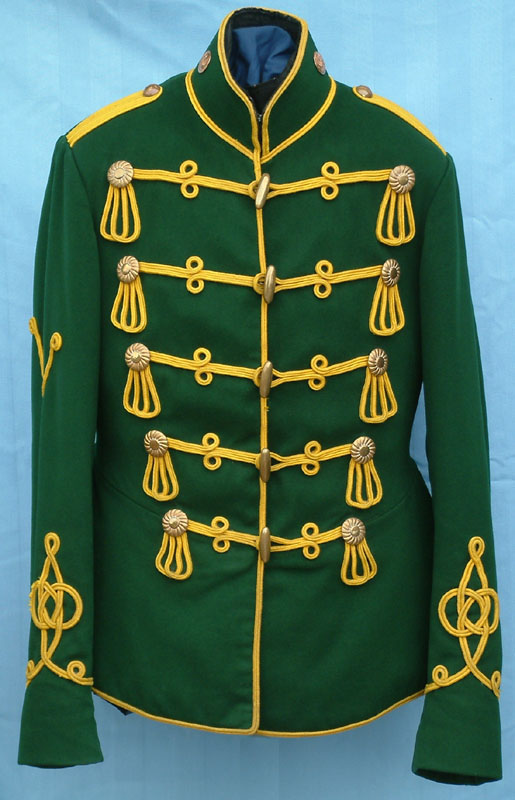|
| The Husaren |
| The colorful uniforms of the Husaren (Light Cavalry) first appeared in 1721 when a blue Kollet (a waist-length jacket with tails) with rows of ornamental braiding on the chest was introduced with a tall, cylindrical piece of headgear called a "Tschako" which was common to most troops in the Napoleonic period. This uniform was worn with minor variations until 1843 when the Garde Husaren Regiment were first introduced with a fur-covered form of headdress called a Pelzmütze (literally a fur cap) which is commonly referred to as a Busby. Line and Leib Husaren Regiments, however, wore a tall cylindrical helmet called "Flügelmütze" (winged cap) which also coincided with a new uniform known as the Attila. The "Flügelmütze" remained in use for Line and Leib Regiments until 1850 when it was replaced by Pelzmütze already in use by the Garde Husaren Regiment. |  | |
 | A detailed discussion of the development of the Pelzmütze (Busby) is far beyond the scope of this guide, but a short overview will be presented here. Issued Pelzmütze were a very tight black-dyed seal fur, except for Husaren Regt Nr. 17 from Braunschweig who wore black-dyed bear fur. Officer Busbies which tend to be much larger in volume, were covered in brown otter fur up to 1912, grey opossum fur after 1912. Like the Pickelhaube, the Busby evolved from the time of introduction until it's final appearance in 1914. The majority of these changes, as with the Pickelhaube, involved the height and various fittings such as chinscales. For a more detailed examination of Pelzmütze, please see the "Imperial German Helmet Patterns Guide" on this web site.
| |
The Attila was made from doeskin wool and was cut short with sleeves below the lower hem. Husaren Attila came in the greatest variety of colors, and examples can be encountered in black, brown, red, dark blue, light blue, and green. Five rows of ornamental braiding was worn on the chest, as well as on the front, collar, cuffs and rear. This braiding is found in white or yellow for Mannschaften (Other Ranks), silver or gilt for officers. The braiding and buttons matched the color of the metal fittings on the Pelzmütze (Busby).
The Husaren regiments where the men had cyphers were 2, 8, 13, and 15. All the others wore blank yellow or white cords. Officer, however, wore cyphers in the above Regts, plus 16, 18, 19, and 20. Men did not. HR7 got their cypher during the war, but like the units above, only officers could wear it. Mannschaften shoulder straps on the M1909 Feldgrau Attila carried the number of the regt or the cypher in brass. In 1915 the Mannschaften shoulder straps carried cord numbers or cyphers.
The color of the Kolpak (Busby bag) which hangs on the left side of the Busby was also specific to the regiment. See the "Uniform Details for all Husaren Regiments" at the top or bottom of this page for details.
|  | |
 |
| Two Attila demonstrating white cording on the left and yellow cording on the left. The Attila on the left is from Husarenen-Regt. Königin Wilhelmena der Niederlande (Hannoversches) Nr.15 and the right Attila is from Magdeburgisches Husarenen-Regt. Nr.10. As with the other Regiments of the Army, NCOs wore silver or gilt lace around the collar and cuffs from the rank of Unteroffizier and above. |
 |
The back of the Attila, showing the cord frogging on the rear skirt. This pattern is unique to Hussar Attilla. Attila liners and internal markings were similar to the Waffenrock.
Mannschaften (Other Ranks) wore black breeches with white or yellow braid, except for Sachsen (Saxon) regiments who wore blue breeches with white or yellow braid. Officers in all regiments wore blue breeches with silver of gilt lace, including the three Regiments which wore the black Attila. | |
| |
|
| |
 |
| |





